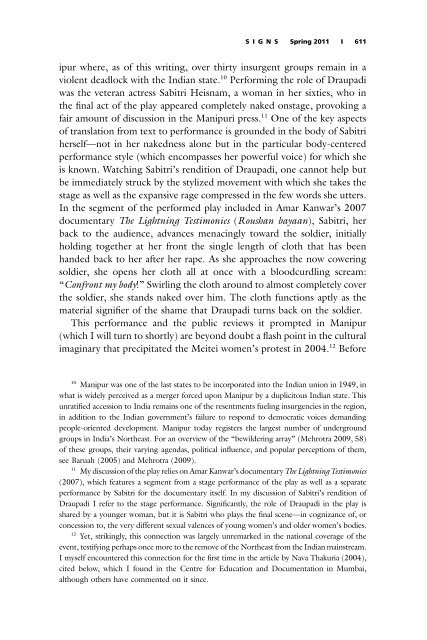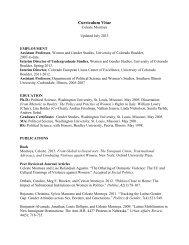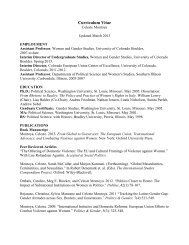Are you a man?: Performing Naked Protest in India - Women and ...
Are you a man?: Performing Naked Protest in India - Women and ...
Are you a man?: Performing Naked Protest in India - Women and ...
Create successful ePaper yourself
Turn your PDF publications into a flip-book with our unique Google optimized e-Paper software.
S I G N S Spr<strong>in</strong>g 2011 ❙ 611<br />
ipur where, as of this writ<strong>in</strong>g, over thirty <strong>in</strong>surgent groups rema<strong>in</strong> <strong>in</strong> a<br />
violent deadlock with the <strong>India</strong>n state. 10 <strong>Perform<strong>in</strong>g</strong> the role of Draupadi<br />
was the veteran actress Sabitri Heisnam, a wo<strong>man</strong> <strong>in</strong> her sixties, who <strong>in</strong><br />
the f<strong>in</strong>al act of the play appeared completely naked onstage, provok<strong>in</strong>g a<br />
fair amount of discussion <strong>in</strong> the Manipuri press. 11 One of the key aspects<br />
of translation from text to perfor<strong>man</strong>ce is grounded <strong>in</strong> the body of Sabitri<br />
herself—not <strong>in</strong> her nakedness alone but <strong>in</strong> the particular body-centered<br />
perfor<strong>man</strong>ce style (which encompasses her powerful voice) for which she<br />
is known. Watch<strong>in</strong>g Sabitri’s rendition of Draupadi, one cannot help but<br />
be immediately struck by the stylized movement with which she takes the<br />
stage as well as the expansive rage compressed <strong>in</strong> the few words she utters.<br />
In the segment of the performed play <strong>in</strong>cluded <strong>in</strong> Amar Kanwar’s 2007<br />
documentary The Lightn<strong>in</strong>g Testimonies (Roushan bayaan), Sabitri, her<br />
back to the audience, advances menac<strong>in</strong>gly toward the soldier, <strong>in</strong>itially<br />
hold<strong>in</strong>g together at her front the s<strong>in</strong>gle length of cloth that has been<br />
h<strong>and</strong>ed back to her after her rape. As she approaches the now cower<strong>in</strong>g<br />
soldier, she opens her cloth all at once with a bloodcurdl<strong>in</strong>g scream:<br />
“Confront my body!” Swirl<strong>in</strong>g the cloth around to almost completely cover<br />
the soldier, she st<strong>and</strong>s naked over him. The cloth functions aptly as the<br />
material signifier of the shame that Draupadi turns back on the soldier.<br />
This perfor<strong>man</strong>ce <strong>and</strong> the public reviews it prompted <strong>in</strong> Manipur<br />
(which I will turn to shortly) are beyond doubt a flash po<strong>in</strong>t <strong>in</strong> the cultural<br />
imag<strong>in</strong>ary that precipitated the Meitei women’s protest <strong>in</strong> 2004. 12 Before<br />
10<br />
Manipur was one of the last states to be <strong>in</strong>corporated <strong>in</strong>to the <strong>India</strong>n union <strong>in</strong> 1949, <strong>in</strong><br />
what is widely perceived as a merger forced upon Manipur by a duplicitous <strong>India</strong>n state. This<br />
unratified accession to <strong>India</strong> rema<strong>in</strong>s one of the resentments fuel<strong>in</strong>g <strong>in</strong>surgencies <strong>in</strong> the region,<br />
<strong>in</strong> addition to the <strong>India</strong>n government’s failure to respond to democratic voices de<strong>man</strong>d<strong>in</strong>g<br />
people-oriented development. Manipur today registers the largest number of underground<br />
groups <strong>in</strong> <strong>India</strong>’s Northeast. For an overview of the “bewilder<strong>in</strong>g array” (Mehrotra 2009, 58)<br />
of these groups, their vary<strong>in</strong>g agendas, political <strong>in</strong>fluence, <strong>and</strong> popular perceptions of them,<br />
see Baruah (2005) <strong>and</strong> Mehrotra (2009).<br />
11<br />
My discussion of the play relies on Amar Kanwar’s documentary The Lightn<strong>in</strong>g Testimonies<br />
(2007), which features a segment from a stage perfor<strong>man</strong>ce of the play as well as a separate<br />
perfor<strong>man</strong>ce by Sabitri for the documentary itself. In my discussion of Sabitri’s rendition of<br />
Draupadi I refer to the stage perfor<strong>man</strong>ce. Significantly, the role of Draupadi <strong>in</strong> the play is<br />
shared by a <strong>you</strong>nger wo<strong>man</strong>, but it is Sabitri who plays the f<strong>in</strong>al scene—<strong>in</strong> cognizance of, or<br />
concession to, the very different sexual valences of <strong>you</strong>ng women’s <strong>and</strong> older women’s bodies.<br />
12<br />
Yet, strik<strong>in</strong>gly, this connection was largely unremarked <strong>in</strong> the national coverage of the<br />
event, testify<strong>in</strong>g perhaps once more to the remove of the Northeast from the <strong>India</strong>n ma<strong>in</strong>stream.<br />
I myself encountered this connection for the first time <strong>in</strong> the article by Nava Thakuria (2004),<br />
cited below, which I found <strong>in</strong> the Centre for Education <strong>and</strong> Documentation <strong>in</strong> Mumbai,<br />
although others have commented on it s<strong>in</strong>ce.






